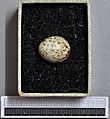Oriental magpie-robin facts for kids
The oriental magpie-robin (Copsychus saularis) is a small, active bird that's part of the passerine group, which means it's a "perching bird." For a long time, people thought it was a type of thrush, but now scientists believe it's actually an Old World flycatcher. These birds are known for their beautiful songs and striking black and white feathers. They are very common in many parts of Asia.
Contents
What is an Oriental Magpie-Robin?
The oriental magpie-robin is a small bird, usually about 19 centimeters (7.5 inches) long, including its tail. It has a long tail that it often holds upright as it hops along the ground. The male birds are mostly black on their upper parts, head, and throat, with a white belly and white patches on their wings. Female birds are similar but have grayish-black upper parts instead of pure black. Both males and females have white on their outer tail feathers.
Where Do Oriental Magpie-Robins Live?
These birds are found across a wide area in Asia. Their home stretches from parts of South Asia, like Bangladesh, India, and Sri Lanka, all the way to Southeast Asia, including countries like Thailand, Malaysia, and Indonesia. They also live in parts of southern China. Oriental magpie-robins prefer to live in open woodlands, gardens, and even urban areas. You can often spot them in parks, near homes, and in cultivated fields. They are quite comfortable living close to people.
Habitat and Environment
Oriental magpie-robins are very adaptable birds. They can live in many different types of environments. You might find them in dense forests, but they are just as happy in open areas with scattered trees. They often choose places where there are plenty of insects to eat and good spots for nesting. Their ability to live in cities shows how well they can adjust to changes in their surroundings.
What Do Oriental Magpie-Robins Eat?
Oriental magpie-robins are mainly insect-eaters. They love to hunt for insects on the ground, hopping around and quickly snatching up their prey. Their diet includes a variety of insects like ants, termites, beetles, and caterpillars. They also eat other small creatures such as worms and spiders. Sometimes, they might even eat small fruits or nectar from flowers, especially when insects are harder to find.
Hunting Habits
These birds are active hunters. They often perch on a low branch or a fence post and watch for movement on the ground. Once they spot an insect, they quickly fly down to catch it. They are also known to forage through leaf litter, using their beaks to flip over leaves and find hidden bugs. Their sharp eyesight and quick movements make them very good at catching their food.
Life Cycle and Reproduction
The breeding season for oriental magpie-robins usually happens between March and July, but this can vary depending on where they live. During this time, the male bird sings loudly to attract a mate and defend his territory.
Nesting and Eggs
Oriental magpie-robins build their nests in tree holes, wall crevices, or even in old tin cans and other man-made structures. The nest is usually a cup-shaped structure made from grass, roots, and other plant materials. The female typically lays 3 to 6 eggs, which are pale blue or greenish-blue with brown spots. Both parents help to incubate the eggs, which means keeping them warm until they hatch. This usually takes about 8 to 14 days.
Raising the Chicks
Once the eggs hatch, both the male and female parents work hard to feed the chicks. The young birds are fed a diet of insects, which helps them grow quickly. The chicks stay in the nest for about 10 to 14 days before they are ready to fledge, or leave the nest for the first time. Even after fledging, the parents continue to feed and care for their young for a few more weeks until they can find food on their own.
How Do Oriental Magpie-Robins Behave?
Oriental magpie-robins are known for their lively behavior and beautiful songs. They are often seen alone or in pairs. They are quite bold and can be seen close to human settlements.
Singing and Calls
The male oriental magpie-robin is a fantastic singer. Its song is a mix of clear, loud whistles and mimicry of other birds' calls. They sing especially during the breeding season to attract mates and mark their territory. They also have a variety of calls for different situations, such as alarm calls when a predator is near. Their songs are often heard early in the morning, making them a common sound in many Asian gardens.
Territorial Behavior
These birds are quite territorial, especially during the breeding season. Males will actively defend their nesting areas from other magpie-robins and sometimes even from other bird species. They use their songs and displays, like puffing up their feathers, to warn off intruders.
Why Are They Important?
The oriental magpie-robin is a very special bird in some countries. For example, it is the national bird of Bangladesh, where it is known as the "Doel." Its presence in gardens and parks helps control insect populations, which is good for the environment. Their beautiful songs also bring joy to many people.
Images for kids
See also
 In Spanish: Shama oriental para niños
In Spanish: Shama oriental para niños







